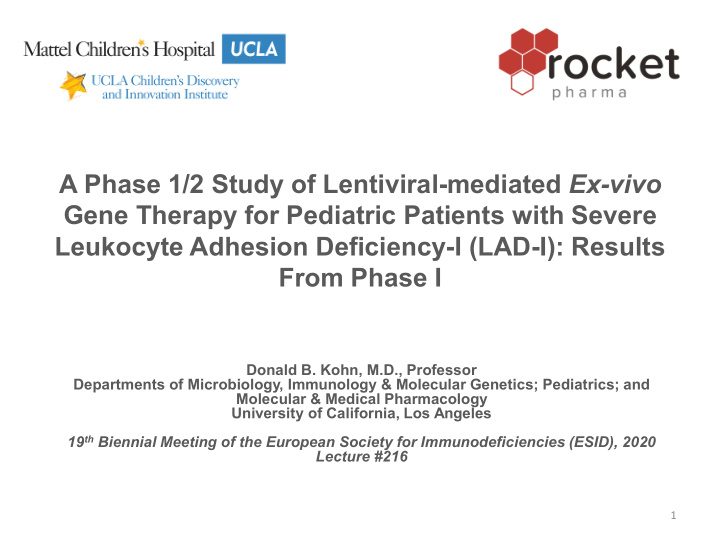



A Phase 1/2 Study of Lentiviral-mediated Ex-vivo Gene Therapy for Pediatric Patients with Severe Leukocyte Adhesion Deficiency-I (LAD-I): Results From Phase I Donald B. Kohn, M.D., Professor Departments of Microbiology, Immunology & Molecular Genetics; Pediatrics; and Molecular & Medical Pharmacology University of California, Los Angeles 19 th Biennial Meeting of the European Society for Immunodeficiencies (ESID), 2020 Lecture #216 1
Conflict of Interest Statement – D.B. Kohn I am a paid member of the Scientific Advisory Boards of Orchard Therapeutics, Allogene Therapeutics and MyoGene Bio The UC Regents have licensed intellectual property on ADA SCID gene therapy on which I am an inventor to Orchard Therapeutics 2
Leukocyte Adhesion Deficiency-I (LAD-I) Monogenic Immunodeficiency Disorder Integrin α ß 2 CD11 CD18 ITGB2 gene • Mutations in the common chain (CD18) of the beta2-integrin family ( ITGB2 gene) prevent expression of CD18/CD11 heterodimers on cell surface essential for cell migration and adhesion • LAD characterized by recurring and ultimately fatal infections due to inability of leukocytes to leave bloodstream to get to sites of tissue infection • Severe inflammatory complications include omphalitis, gingivitis and ulcerative skin lesions • Current Treatment Option: Allogeneic HSCT. May be limited by availability of suitable donor, GvHD, infections. Qasim W et al. Pediatrics 2009; 123: 836-40 3 Almarza Novoa E et al. J Allergy Clin Immunol Pract. 2018 July-August (6) 1418-1420.
Clinical Pathogenesis of LAD-I Kaplan-Meier Survival Estimates by LAD-I Disease Spectrum Neutrophil CD18 Expression Patients with severe & moderate LAD-I not receiving allogeneic HSCT Moderate: Severe: 2-30% <2% CD18+ PMN CD18+ PMN PMN = polymorphonuclear leukocytes LAD-I Clinical Prognosis • Patients suffer from recurrent infections; fatal in majority • 60-75% with severe LAD-I die prior to age 2 • >50% with moderate LAD-I die before age 40 The grey diamond indicates the 39% survival to age 2 years for 66 evaluable patients with severe LAD-I not receiving HSCT Almarza Novoa E et al. J Allergy Clin Immunol Pract. 2018 4 July-August (6) 1418-1420.
Gene Therapy for LAD-I - RP-L201 Ex-vivo lentiviral vector gene therapy consists of autologous CD34+ cells transduced with a lentiviral vector (Chim-CD18-WPRE LV) encoding for the CD18 ( β -subunit) component of β 2-integrin Developed at CIEMAT, in partnership with UCL • CD34+ cells are mobilized to PB with G-CSF and plerixafor • Cells are collected via apheresis • Following transduction & cryopreservation, TDM-Busulfan conditioning is administered prior to infusion of RP-L201 5
RP-L201 LAD-I Clinical Trial and Outcome Measures 1 Trial Design – Non-Randomized Global Phase 1/2 Study Phase 1 (n=2): COMPLETED Phase 2 (n=7): Currently Enrolling Primary Outcomes Secondary Outcomes • % of pts w/neutrophil CD18 expression at least • Phase 1: 10% of normal • Safety & preliminary efficacy • % of pts w/neutrophil VCN of at least 0.1 • Phase 2: copies/cell at 6m post-rx • Survival: proportion of patients alive at age • Incidence and severity of infections 2 and at least 1-year post infusion (& not • Improvement/normalization of neutrophilia requiring alloHSCT) • Resolution (partial or complete) of underlying • Safety skin rash or periodontal abnormalities 6 1 https://clinicaltrials.gov/ct2/show/NCT03812263?cond=Leukocyte+Adhesion+Deficiency&rank=5
Phase 1: Subject L201-003-1001 12 Months Follow-up
Medical History of Subject L-201-003-1001 Hospitalized Hospitalized IV Abx, Transfusion IV Abx, Steroids Suspected Nocardia 9-y.o. female Multiple Abscesses Pneumonia Buttocks diagnosed with Severe Anemia Hospitalized IV Abx, Ustekinumab severe LAD-I at age 7 Enbrel, Abx Pyoderma Gangrenosum Ulcer R-Leg Lower Back (BM Bx site) Age 1 2 3 4 5 6 7 8 9 10 (Years) Dx with LAD Pseudomonas Skin Infection Lesion on Thigh Hospitalized Ecthyma/Pyoderma Pyoderma Gangrenosum Humira Gangrenosum Abdomen IV Abx, PO Steroids, Multiple Aspergilloma Hospitalized IV Abx, Ustekinumab Wound Debridement (Pulmonary) Partial Lung Resection, Hospitalized Skin Lesions L-flank & Antifungal, Abx Buttocks IV Abx, IV Steroids, Daily Wound Care, Enbrel Prophylactic Antifungal and Antibiotic Rx Recurrent URI, UTI, Otitis Media, Asthma Historical patient records collected by UCLA Mattel Children’s Hospital 8 LAD has received CIRM Funding
Subject L201-003-1001: 12 Month Follow-Up Key Drug Product Metrics CD34+ Cell Dose: 4.2 x 10 6 cells/kg Drug Product VCN: 3.8 PBMC VCN % CD18 Expression (PMN) 36 9 PBMC: peripheral blood mononuclear cell PMN: neutrophil
RP-L201: Visible Improvements Post-Treatment Spontaneous Abdominal Lesion Baseline 3M 6M 12 M (Pre-Treatment) UCLA Mattel Children’s Hospital Data Sep 2020 10 LAD has received CIRM Funding
Phase 1: Subject L201-003-1004 4 Months Follow-up
Medical History of Subject L-201-003-1004 3-y.o. female Gingivitis/Periodontiis • Delayed umbilical cord separation • Diagnosed with LAD-I at age 3 Keflex • Keflex 2 younger siblings diagnosed LAD-I Recurrent Cellulitis Birth 1 2 3 12/2015 12/2018 12/2016 12/2017 Dx with LAD Hospitalized URI Recurrent Fever Otitis Media B/L Tympanic Perforation B/L PET Tympanoplasty Hospitalized Fever/RSV/perianal rash Historical patient records collected by UCLA Mattel Children’s Hospital 12
Subject L201-003-1004: 4 Month Follow-Up Key Drug Product Metrics 2.8 x 10 6 cells/kg CD34+ Cell Dose Drug Product VCN 2.5 • CD18 expression at 4 months: 28% • Early VCN results trending similar to Subject L201-003-1004; 3-month VCN pending • Periodontitis present at baseline is resolving 13
Conclusions • Two severe LAD-I patients have been successfully infused with RP-L201, an ex-vivo LV autologous HSPC gene therapy - One pt with 12M follow-up and second pt with 4M follow-up • Safety profile of RP-L201 appears favorable - Infusion well tolerated; no IP-related SAEs or severe AEs - Both subjects achieved hematopoietic reconstitution in less than 4 weeks • Preliminary efficacy evident in both subjects - Subject L201-003-1001 with durable CD18+ PMN expression >35% at 12-months post-treatment, PB VCN of 1.0 at 9-months, and visible signs of improvement in existing skin lesions - Subject L201-003-1004 with CD18+ PMN expression at 28% at 4- months post-treatment and early PB VCN trending similar to first subject 14
Acknowledgements 15
Recommend
More recommend